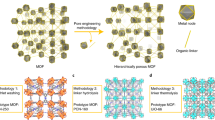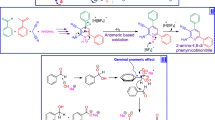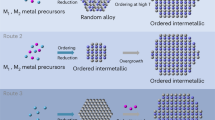Abstract
The synthesis of NU-1000, a highly robust mesoporous (containing pores >2 nm) metal-organic framework (MOF), can be conducted efficiently on a multigram scale from inexpensive starting materials. Tetrabromopyrene and (4-(ethoxycarbonyl)phenyl)boronic acid can easily be coupled to prepare the requisite organic strut with four metal-binding sites in the form of four carboxylic acids, while zirconyl chloride octahydrate is used as a precursor for the well-defined metal oxide clusters. NU-1000 has been reported as an excellent candidate for the separation of gases, and it is a versatile scaffold for heterogeneous catalysis. In particular, it is ideal for the catalytic deactivation of nerve agents, and it shows great promise as a new generic platform for a wide range of applications. Multiple post-synthetic modification protocols have been developed using NU-1000 as the parent material, making it a potentially useful scaffold for several catalytic applications. The procedure for the preparation of NU-1000 can be scaled up reliably, and it is suitable for the production of 50 g of the tetracarboxylic acid containing organic linker and 200 mg–2.5 g of NU-1000. The entire synthesis is performed without purification by column chromatography and can be completed within 10 d.
This is a preview of subscription content, access via your institution
Access options
Subscribe to this journal
Receive 12 print issues and online access
$259.00 per year
only $21.58 per issue
Buy this article
- Purchase on Springer Link
- Instant access to full article PDF
Prices may be subject to local taxes which are calculated during checkout















Similar content being viewed by others
References
Ferey, G. Hybrid porous solids: past, present, future. Chem. Soc. Rev. 37, 191–214 (2008).
Horike, S., Shimomura, S. & Kitagawa, S. Soft porous crystals. Nat. Chem. 1, 695–704 (2009).
Furukawa, H., Cordova, K.E., O'Keeffe, M. & Yaghi, O.M. The chemistry and applications of metal-organic frameworks. Science 341, 974 (2013).
Farha, O.K. & Hupp, J.T. Rational design, synthesis, purification, and activation of metal-organic framework materials. Acc. Chem. Res. 43, 1166–1175 (2010).
Murray, L.J., Dinca, M. & Long, J.R. Hydrogen storage in metal-organic frameworks. Chem. Soc. Rev. 38, 1294–1314 (2009).
Farha, O.K. et al. De novo synthesis of a metal-organic framework material featuring ultrahigh surface area and gas storage capacities. Nat. Chem. 2, 944–948 (2010).
Suh, M.P., Park, H.J., Prasad, T.K. & Lim, D.-W. Hydrogen storage in metal-organic frameworks. Chem. Rev. 112, 782–835 (2012).
Farha, O.K. et al. Metal-organic framework materials with ultrahigh surface areas: is the sky the limit? J. Am. Chem. Soc. 134, 15016–15021 (2012).
Li, J.-R., Sculley, J. & Zhou, H.-C. Metal-organic frameworks for separations. Chem. Rev. 112, 869–932 (2011).
Deria, P. et al. Perfluoroalkane functionalization of NU-1000 via solvent-assisted ligand incorporation: synthesis and CO2 adsorption studies. J. Am. Chem. Soc. 135, 16801–16804 (2013).
Lee, J. et al. Metal-organic framework materials as catalysts. Chem. Soc. Rev. 38, 1450–1459 (2009).
Kreno, L.E. et al. Metal-organic framework materials as chemical sensors. Chem. Rev. 112, 1105–1125 (2011).
So, M.C., Wiederrecht, G.P., Mondloch, J.E., Hupp, J.T. & Farha, O.K. Metal-organic framework materials for light-harvesting and energy transfer. Chem. Commun. 51, 3501–3510 (2015).
He, C., Lu, K., Liu, D. & Lin, W. Nanoscale metal-organic frameworks for the co-delivery of cisplatin and pooled siRNAs to enhance therapeutic efficacy in drug-resistant ovarian cancer cells. J. Am. Chem. Soc. 136, 5181–5184 (2014).
McKinlay, A.C. et al. Multirate delivery of multiple therapeutic agents from metal-organic frameworks. APL Mater. 2, 124108 (2014).
Mondloch, J.E. et al. Vapor-phase metalation by atomic layer deposition in a metal-organic framework. J. Am. Chem. Soc. 135, 10294–10297 (2013).
Deria, P., Bury, W., Hupp, J.T. & Farha, O.K. Versatile functionalization of the NU-1000 platform by solvent-assisted ligand incorporation. Chem. Commun. 50, 1965–1968 (2014).
Deria, P. et al. MOF functionalization via solvent-assisted ligand incorporation: phosphonates vs. carboxylates. Inorg. Chem. 54, 2185–2192 (2015).
Johnston, R.L. & Hoffmann, R. The kagomé net: band theoretical and topological aspects. Polyhedron 9, 1901–1911 (1990).
Planas, N. et al. Defining the proton topology of the Zr6-based metal-organic framework NU-1000. J. Phys. Chem. Lett. 5, 3716–3723 (2014).
Mondloch, J.E. et al. Are Zr6-based MOFs water stable? Linker hydrolysis vs. capillary-force-driven channel collapse. Chem. Commun. 50, 8944–8946 (2014).
Beyzavi, M.H. et al. A Hafnium-based metal-organic framework as an efficient and multifunctional catalyst for facile CO2 fixation and regioselective and enantioretentive epoxide activation. J. Am. Chem. Soc. 136, 15861–15864 (2014).
Katz, M.J. et al. Simple and compelling biomimetic metal-organic framework catalyst for the degradation of nerve agent simulants. Angew. Chem. Int. Ed. Engl. 53, 497–501 (2013).
Mondloch, J.E. et al. Destruction of chemical warfare agents using metal-organic frameworks. Nat. Mater. 14, 512–516 (2015).
Hod, I. et al. Directed growth of electroactive metal-organic framework thin films using electrophoretic deposition. Adv. Mater. 26, 6295–6300 (2014).
Deria, P. et al. A MOF platform for incorporation of complementary organic motifs for CO2 binding. Chem. Commun. 51, 12478–12481 (2015).
Hod, I. et al. Bias-switchable permselectivity and redox catalytic activity of a ferrocene-functionalized, thin-film metal-organic framework compound. J. Phys. Chem. Lett. 6, 586–591 (2015).
Karagiaridi, O., Bury, W., Sarjeant, A.A., Hupp, J.T. & Farha, O.K. Synthesis and characterization of functionalized metal-organic frameworks. J. Vis. Exp. 91, e52094 (2014).
Acknowledgements
This work (MOF assembly, experimental characterization and AIM) was supported as part of the Inorganometallic Catalyst Design Center, an Energy Frontier Research Center, funded by the US Department of Energy, Office of Science, Basic Energy Sciences, under Award no. DESC0012702 (to O.K.F., A.B.F.M. and J.T.H.). This research is part (project 34-944) of the Joint Center of Excellence in Integrated Nano-Systems (JCIN) at King Abdulaziz City for Science and Technology (KACST) and Northwestern University (NU; to J.F.S.). The authors thank both KACST and NU for their continued support of this research.
Author information
Authors and Affiliations
Contributions
T.C.W., N.A.V. and O.K.F. designed the experiments; T.C.W. and N.A.V. performed the synthesis of the strut and analyzed the collected data, and T.C.W. designed and performed the synthesis of NU-1000 with guidance from O.K.F.; I.S.K. performed the ALD experiments with guidance from A.B.F.M.; and T.C.W., N.A.V., I.S.K., A.B.F.M., J.F.S., J.T.H. and O.K.F. wrote the manuscript.
Corresponding author
Ethics declarations
Competing interests
J.T.H. and O.K.F. have a financial interest in the startup company NuMat Technologies, which is seeking to commercialize metal-organic frameworks.
Rights and permissions
About this article
Cite this article
Wang, T., Vermeulen, N., Kim, I. et al. Scalable synthesis and post-modification of a mesoporous metal-organic framework called NU-1000. Nat Protoc 11, 149–162 (2016). https://doi.org/10.1038/nprot.2016.001
Published:
Issue Date:
DOI: https://doi.org/10.1038/nprot.2016.001
This article is cited by
-
Creating hierarchical pores in metal–organic frameworks via postsynthetic reactions
Nature Protocols (2023)
-
Enhancement of visible-light-driven oxidative amine coupling under aerobic and anaerobic conditions by photocatalyst with spatial separation of photoinduced charge carriers
Nano Research (2023)
-
Exchange controlled triplet fusion in metal–organic frameworks
Nature Materials (2022)
-
Applying design principles to improve hydrogen storage capacity in nanoporous materials
Brazilian Journal of Chemical Engineering (2022)
-
Reticular chemistry in electrochemical carbon dioxide reduction
Science China Materials (2020)
Comments
By submitting a comment you agree to abide by our Terms and Community Guidelines. If you find something abusive or that does not comply with our terms or guidelines please flag it as inappropriate.



